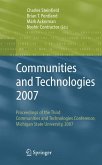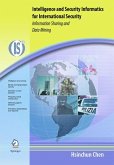"Aaron Mannes and V.S. Subrahmanian have produced a fascinating framework for a disciplined analysis of terrorist groups..." -- R. James Woolsey, Director - Central Intelligence Agency (1993-1995)
"This important book contains a number of policy suggestions that provide a framework which could help mitigate future LeT terror attacks, and ultimately save lives. As a former Director of National Intelligence, I know this book will be an invaluable asset to counter-terrorism analysts and policymakers. It is a must read." -- J. Mike McConnell, Director of National Intelligence (2007-2009)
"Lashkar-e-Taiba is perhaps the most dangerous jihadist group of global reach after al-Qaeda and is arguably the more complicated actor of the two. Understanding it requires creative thinking and analysis of exactly the sort VS Subrahmanian and Aaron Mannes offer in this important contribution to the growing Lashkar canon. Highly recommended for policymakers, practitioners and anyone interested knowing more about the South Asian region or transnational terrorism." -- Stephen Tankel, author of "Storming the World Stage: The Story of Lashkar-e-Taiba" (Columbia/Hurst), 2012, and Assistant Professor, American University
"The book presents a very pragmatic application of "Temporal Probabilistic Behavior Rules" and "Policy Analysis Methodology" to successfully attempting a possible solution to one of the most serious threat to the National Security of any sovereign country i.e. terrorism. The author's exemplary approach and visualization can be applied to solving a variety of other problems, including organized crimes, crime by mafias and even insurgency. With further fine tuning of the algorithms and methodology this unique approach could yield even far reaching results to the issues and challenges of public safety in general and national security in particular." -- Dr. Nirmaljeet Singh Kalsi, Joint Secretary, Ministry of Home Affairs, Government of India.
"With this monograph V.S. Subrahmanian and his collaborators offer a promising new predictive tool for the study of terrorist groups. Focusing on Pakistan's militant Lashkar-e-Taiba, the authors use computational analysis to generate a set of relationships that confirm and extend our understanding of the relationship between various political environment factors and terrorist operations. These findings lead to several policy recommendations on means to reduce the likelihood of terrorist attacks. Although the Subrahmanian team has focused on a single organization, their analytic approach should have application to the study of Pakistan's other terrorist organizations and those elsewhere. The book's rich overview of Lashka-e-Taiba's goals, organization, relationships and operations reveals a group with a deep domestic base and growing international reach that might in the future allow it to surpass Al Qaeda as a global threat." -- Marvin Weinbaum, Middle East Institute and Professor Emeritus, University of Illinois at Urbana Champaign
"This book must be admired for its sheer novelty of approach in applying computational analysis to a most unusual subject. Analytical tools from diverse disciplines converge to provide the reader with an indepth understanding of the secret world of terrorism. Fascinating!" -- S. Ramadorai, Advisor to the Prime Minister of India, Vice-Chairman, Tata Consultancy Services, Chairman of the Bombay Stock Exchange.
"The first successful computational intelligence system for real time data mining of worldwide terrorism activities. Its signal importance is that It can provide to the counter terrorism community much needed timely group and site specific assessments of threats worldwide." -- Anil Nerode, Goldwin Smith Professor of Mathematics and Computer Science, Cornell University
"The forthcoming work by the Univ. Maryland would be unique and it certainly paves the way at least to popularize predictive modeling or use of scientific technique in studying social sciences like what this new book has followed. This book would certainly enthuse others to explore possibility to use this technique with other groups (e.g Al Qaeda in Yemen, Indian Mujaheddin etc ). It would help both policy makers and security agencies....esp when they are investing in building huge database (open source and otherwise) on Terrorism, low intensity Conflicts.
This book is different from the existing literature on LeT, I have read so far....and it sheds some lights on what the terrorist group would probably do next." -- Animesh Roul, Executive Director - Society for the Study of Peace and Conflict, New Delhi.
"This book provides a thorough and systematic method to analyze the behavior of Laskhar-e-Taiba. Furthermore it provides a framework to analyze the behavior of any terror group and also to make forecasts and predictions about future actions of such a group. Hence, a must read for both the intelligence analyst faced with huge amounts of data and academic researchers working on computational methodology to analyze such organizations. Professor Subrahmanian and his team have set a new standard for the computational analysis of terrorist organizations." -- Roy Lindelauf, Researcher, Netherlands Defense Academy - Military Operational Science.
"The book presents a very pragmatic application of "Temporal Probabilistic Behavior Rules" and "Policy Analysis Methodology" to successfully attempting a possible solution to one of the most serious threat to the National Security of any sovereign country i.e. terrorism. The author's exemplary approach and visualization can be applied to solving a variety of other problems, including organized crimes, crime by mafias and even insurgency. With further fine tuning of the algorithms and methodology this unique approach could yield even far reaching results to the issues and challenges of public safety in general and national security in particular." -- Dr. Nirmaljeet Singh Kalsi, Joint Secretary, Ministry of Home Affairs, Government of India.
"With this monograph V.S. Subrahmanian and his collaborators offer a promising new predictive tool for the study of terrorist groups. Focusing on Pakistan's militant Lashkar-e-Taiba, the authors use computational analysis to generate a set of relationships that confirm and extend our understanding of the relationship between various political environment factors and terrorist operations. These findings lead to several policy recommendations on means to reduce the likelihood of terrorist attacks. Although the Subrahmanian team has focused on a single organization, their analytic approach should have application to the study of Pakistan's other terrorist organizations and those elsewhere. The book's rich overview of Lashka-e-Taiba's goals, organization, relationships and operations reveals a group with a deep domestic base and growing international reach that might in the future allow it to surpass Al Qaeda as a global threat." -- Marvin Weinbaum, Middle East Institute and Professor Emeritus, University of Illinois at Urbana Champaign
"This book must be admired for its sheer novelty of approach in applying computational analysis to a most unusual subject. Analytical tools from diverse disciplines converge to provide the reader with an indepth understanding of the secret world of terrorism. Fascinating!" -- S. Ramadorai, Advisor to the Prime Minister of India, Vice-Chairman, Tata Consultancy Services, Chairman of the Bombay Stock Exchange.
"The first successful computational intelligence system for real time data mining of worldwide terrorism activities. Its signal importance is that It can provide to the counter terrorism community much needed timely group and site specific assessments of threats worldwide." -- Anil Nerode, Goldwin Smith Professor of Mathematics and Computer Science, Cornell University
"The forthcoming work by the Univ. Maryland would be unique and it certainly paves the way at least to popularize predictive modeling or use of scientific technique in studying social sciences like what this new book has followed. This book would certainly enthuse others to explore possibility to use this technique with other groups (e.g Al Qaeda in Yemen, Indian Mujaheddin etc ). It would help both policy makers and security agencies....esp when they are investing in building huge database (open source and otherwise) on Terrorism, low intensity Conflicts.
This book is different from the existing literature on LeT, I have read so far....and it sheds some lights on what the terrorist group would probably do next." -- Animesh Roul, Executive Director - Society for the Study of Peace and Conflict, New Delhi.
"This book provides a thorough and systematic method to analyze the behavior of Laskhar-e-Taiba. Furthermore it provides a framework to analyze the behavior of any terror group and also to make forecasts and predictions about future actions of such a group. Hence, a must read for both the intelligence analyst faced with huge amounts of data and academic researchers working on computational methodology to analyze such organizations. Professor Subrahmanian and his team have set a new standard for the computational analysis of terrorist organizations." -- Roy Lindelauf, Researcher, Netherlands Defense Academy - Military Operational Science.
"This important book contains a number of policy suggestions that provide a framework which could help mitigate future LeT terror attacks, and ultimately save lives. As a former Director of National Intelligence, I know this book will be an invaluable asset to counter-terrorism analysts and policymakers. It is a must read." -- J. Mike McConnell, Director of National Intelligence (2007-2009)
"Lashkar-e-Taiba is perhaps the most dangerous jihadist group of global reach after al-Qaeda and is arguably the more complicated actor of the two. Understanding it requires creative thinking and analysis of exactly the sort VS Subrahmanian and Aaron Mannes offer in this important contribution to the growing Lashkar canon. Highly recommended for policymakers, practitioners and anyone interested knowing more about the South Asian region or transnational terrorism." -- Stephen Tankel, author of "Storming the World Stage: The Story of Lashkar-e-Taiba" (Columbia/Hurst), 2012, and Assistant Professor, American University
"The book presents a very pragmatic application of "Temporal Probabilistic Behavior Rules" and "Policy Analysis Methodology" to successfully attempting a possible solution to one of the most serious threat to the National Security of any sovereign country i.e. terrorism. The author's exemplary approach and visualization can be applied to solving a variety of other problems, including organized crimes, crime by mafias and even insurgency. With further fine tuning of the algorithms and methodology this unique approach could yield even far reaching results to the issues and challenges of public safety in general and national security in particular." -- Dr. Nirmaljeet Singh Kalsi, Joint Secretary, Ministry of Home Affairs, Government of India.
"With this monograph V.S. Subrahmanian and his collaborators offer a promising new predictive tool for the study of terrorist groups. Focusing on Pakistan's militant Lashkar-e-Taiba, the authors use computational analysis to generate a set of relationships that confirm and extend our understanding of the relationship between various political environment factors and terrorist operations. These findings lead to several policy recommendations on means to reduce the likelihood of terrorist attacks. Although the Subrahmanian team has focused on a single organization, their analytic approach should have application to the study of Pakistan's other terrorist organizations and those elsewhere. The book's rich overview of Lashka-e-Taiba's goals, organization, relationships and operations reveals a group with a deep domestic base and growing international reach that might in the future allow it to surpass Al Qaeda as a global threat." -- Marvin Weinbaum, Middle East Institute and Professor Emeritus, University of Illinois at Urbana Champaign
"This book must be admired for its sheer novelty of approach in applying computational analysis to a most unusual subject. Analytical tools from diverse disciplines converge to provide the reader with an indepth understanding of the secret world of terrorism. Fascinating!" -- S. Ramadorai, Advisor to the Prime Minister of India, Vice-Chairman, Tata Consultancy Services, Chairman of the Bombay Stock Exchange.
"The first successful computational intelligence system for real time data mining of worldwide terrorism activities. Its signal importance is that It can provide to the counter terrorism community much needed timely group and site specific assessments of threats worldwide." -- Anil Nerode, Goldwin Smith Professor of Mathematics and Computer Science, Cornell University
"The forthcoming work by the Univ. Maryland would be unique and it certainly paves the way at least to popularize predictive modeling or use of scientific technique in studying social sciences like what this new book has followed. This book would certainly enthuse others to explore possibility to use this technique with other groups (e.g Al Qaeda in Yemen, Indian Mujaheddin etc ). It would help both policy makers and security agencies....esp when they are investing in building huge database (open source and otherwise) on Terrorism, low intensity Conflicts.
This book is different from the existing literature on LeT, I have read so far....and it sheds some lights on what the terrorist group would probably do next." -- Animesh Roul, Executive Director - Society for the Study of Peace and Conflict, New Delhi.
"This book provides a thorough and systematic method to analyze the behavior of Laskhar-e-Taiba. Furthermore it provides a framework to analyze the behavior of any terror group and also to make forecasts and predictions about future actions of such a group. Hence, a must read for both the intelligence analyst faced with huge amounts of data and academic researchers working on computational methodology to analyze such organizations. Professor Subrahmanian and his team have set a new standard for the computational analysis of terrorist organizations." -- Roy Lindelauf, Researcher, Netherlands Defense Academy - Military Operational Science.
"The book presents a very pragmatic application of "Temporal Probabilistic Behavior Rules" and "Policy Analysis Methodology" to successfully attempting a possible solution to one of the most serious threat to the National Security of any sovereign country i.e. terrorism. The author's exemplary approach and visualization can be applied to solving a variety of other problems, including organized crimes, crime by mafias and even insurgency. With further fine tuning of the algorithms and methodology this unique approach could yield even far reaching results to the issues and challenges of public safety in general and national security in particular." -- Dr. Nirmaljeet Singh Kalsi, Joint Secretary, Ministry of Home Affairs, Government of India.
"With this monograph V.S. Subrahmanian and his collaborators offer a promising new predictive tool for the study of terrorist groups. Focusing on Pakistan's militant Lashkar-e-Taiba, the authors use computational analysis to generate a set of relationships that confirm and extend our understanding of the relationship between various political environment factors and terrorist operations. These findings lead to several policy recommendations on means to reduce the likelihood of terrorist attacks. Although the Subrahmanian team has focused on a single organization, their analytic approach should have application to the study of Pakistan's other terrorist organizations and those elsewhere. The book's rich overview of Lashka-e-Taiba's goals, organization, relationships and operations reveals a group with a deep domestic base and growing international reach that might in the future allow it to surpass Al Qaeda as a global threat." -- Marvin Weinbaum, Middle East Institute and Professor Emeritus, University of Illinois at Urbana Champaign
"This book must be admired for its sheer novelty of approach in applying computational analysis to a most unusual subject. Analytical tools from diverse disciplines converge to provide the reader with an indepth understanding of the secret world of terrorism. Fascinating!" -- S. Ramadorai, Advisor to the Prime Minister of India, Vice-Chairman, Tata Consultancy Services, Chairman of the Bombay Stock Exchange.
"The first successful computational intelligence system for real time data mining of worldwide terrorism activities. Its signal importance is that It can provide to the counter terrorism community much needed timely group and site specific assessments of threats worldwide." -- Anil Nerode, Goldwin Smith Professor of Mathematics and Computer Science, Cornell University
"The forthcoming work by the Univ. Maryland would be unique and it certainly paves the way at least to popularize predictive modeling or use of scientific technique in studying social sciences like what this new book has followed. This book would certainly enthuse others to explore possibility to use this technique with other groups (e.g Al Qaeda in Yemen, Indian Mujaheddin etc ). It would help both policy makers and security agencies....esp when they are investing in building huge database (open source and otherwise) on Terrorism, low intensity Conflicts.
This book is different from the existing literature on LeT, I have read so far....and it sheds some lights on what the terrorist group would probably do next." -- Animesh Roul, Executive Director - Society for the Study of Peace and Conflict, New Delhi.
"This book provides a thorough and systematic method to analyze the behavior of Laskhar-e-Taiba. Furthermore it provides a framework to analyze the behavior of any terror group and also to make forecasts and predictions about future actions of such a group. Hence, a must read for both the intelligence analyst faced with huge amounts of data and academic researchers working on computational methodology to analyze such organizations. Professor Subrahmanian and his team have set a new standard for the computational analysis of terrorist organizations." -- Roy Lindelauf, Researcher, Netherlands Defense Academy - Military Operational Science.









